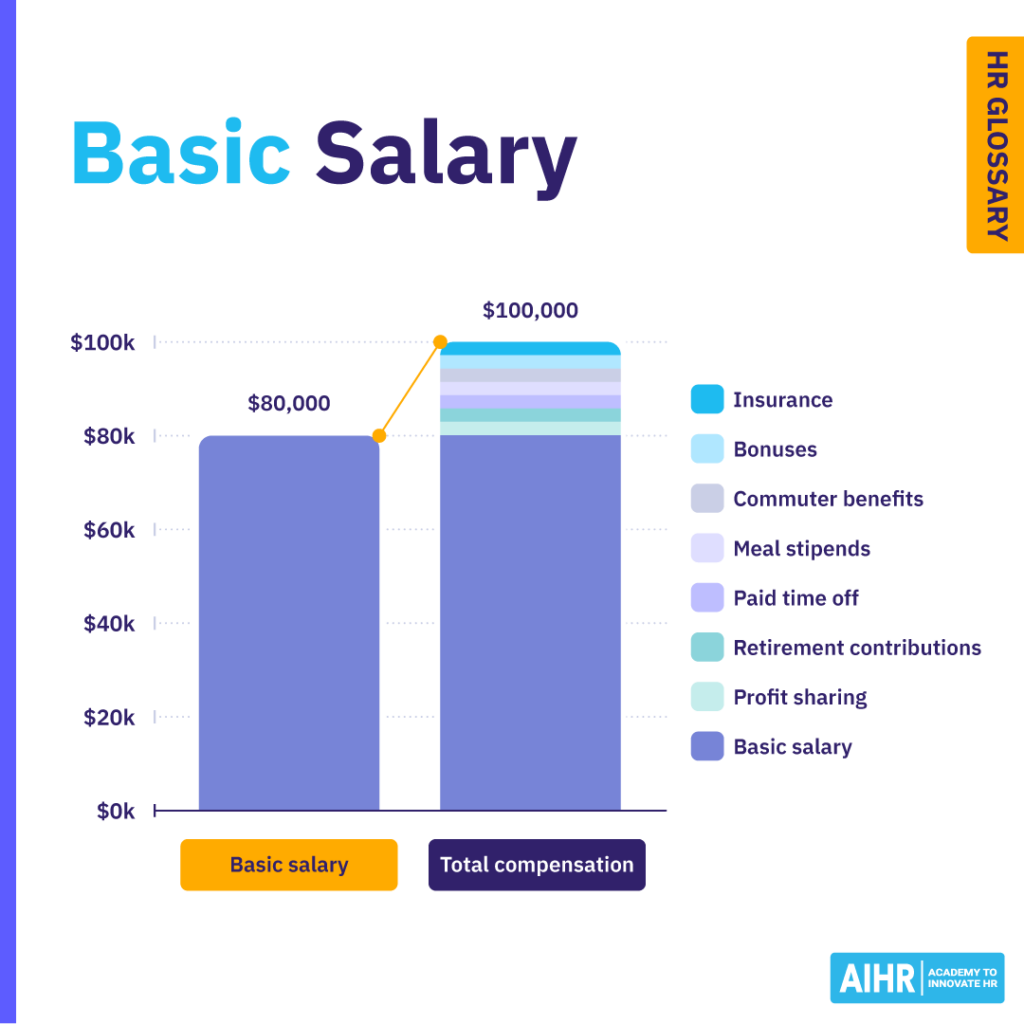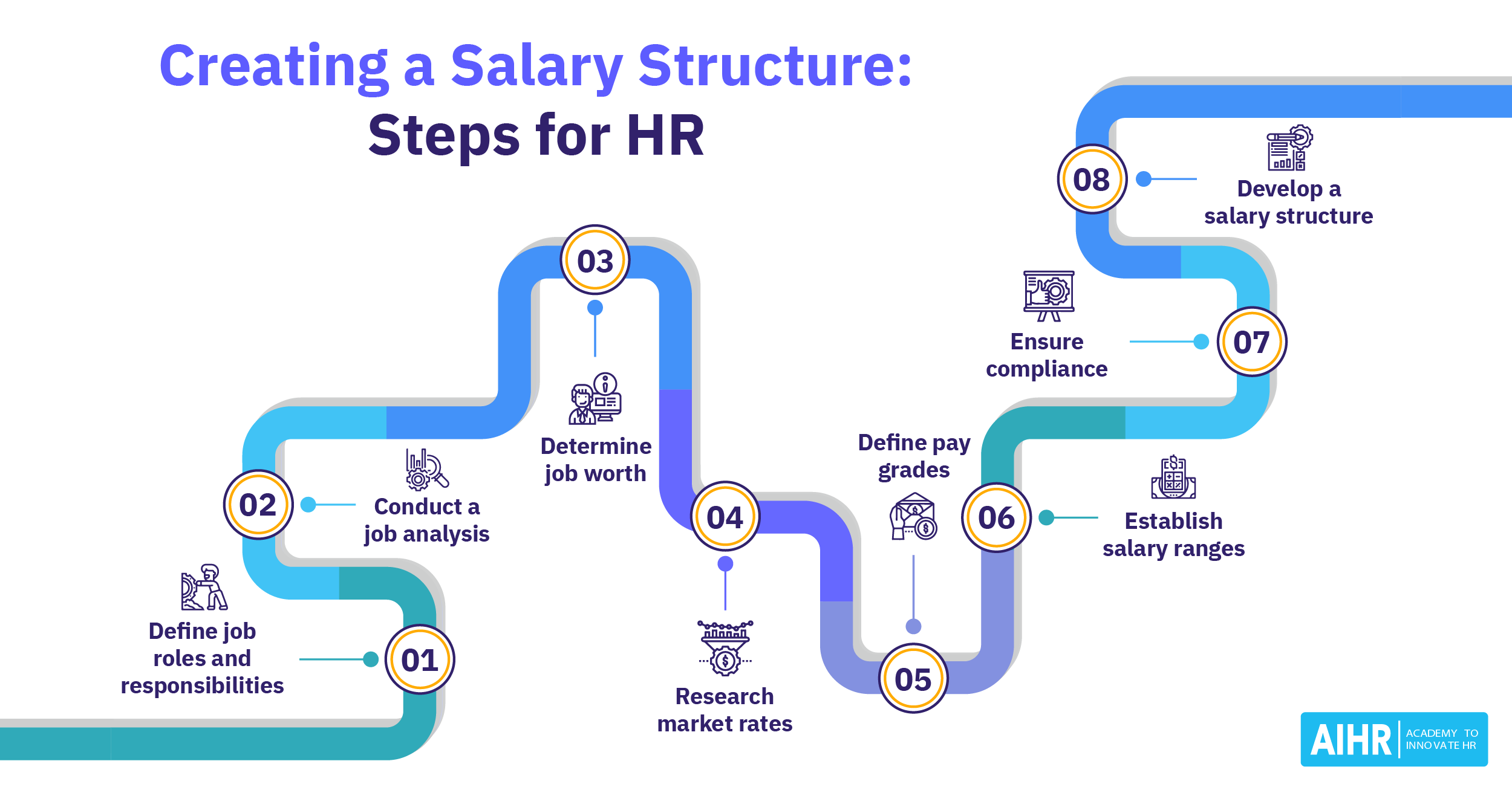Basic Salary
Basic salary meaning
Basic salary, or base pay, is the fixed amount employees receive before any additional payments or deductions are made. This amount doesn’t include benefits, bonuses, commissions, or other types of compensation. For example, an employee earns a basic salary of $80,000 per year but receives an average of $12,000 in bonuses. The $80,000 remains consistent regardless of any extras.
Base pay typically refers to an employee’s annual earnings but can also be calculated monthly or weekly. It’s important for HR to understand a role’s base pay for talent attraction and retention, budgeting, and performance management.

How is basic salary determined?
Establishing an attractive and competitive basic salary depends on considering various factors, such as:
- Job role and responsibilities: Compensation is impacted by the type of position, its complexity, required skills, and duties. Roles with specialized or demanding tasks often command higher pay.
- Education and qualifications: An employee’s level of education, type of degree, or specialized training can affect their earnings. Base pay for roles requiring advanced degrees can differ greatly from that of those without a degree requirement.
- Level of experience: The amount of previous experience is often considered when establishing base pay. A new graduate’s earnings will be substantially lower than that of an experienced professional with years of experience and proven expertise.
- Market benchmarking: The demand for certain roles and skill sets can influence compensation levels. High-demand professions like healthcare, technology, and engineering usually have above-average basic salaries.
- Location: Geographic factors such as cost of living affect pay rates. For instance, salaries in major cities tend to exceed those in rural areas. Minimum wage requirements in specific states or countries can also influence starting amounts.
Basic salary vs. gross salary vs net salary
Let’s look at the key differences between basic salary, gross salary, and net salary in the following example:
A financial analyst in Boston earns a basic salary of $6,500 per month.
- Gross salary: Represents the total income before deductions, including base pay and any additional earnings like bonuses or incentives. For instance, if the analyst earns an extra $600 in incentive pay, their gross earnings would total $7,100 ($6,500 + $600).
- Net salary: This is the actual salary an employee takes home after all deductions, such as local, state, and federal taxes, Social Security and Medicare contributions, health insurance premiums, and retirement contributions. The net salary (gross salary – deductions) in this example would be $5,325 [$7,100 (gross salary) – $1,775 in (deductions)].
Summary:
- Basic salary: $6,500
- Gross salary: $7,100 (basic salary of $6,500 + additional pay of $600)
- Net salary: $5,325 (minus standard deductions of taxes, etc.)
Learn how to develop a successful compensation strategy
Basic salary is the backbone of any compensation strategy, impacting talent attraction, retention, and overall financial planning. Understanding how to structure, calculate, and benchmark base pay is essential for maintaining fairness, competitiveness, and alignment with business goals.
In AIHR’s Compensation & Benefits Certificate Program, you’ll gain the skills to design effective salary structures, analyze compensation data, and ensure your pay practices are both equitable and strategic.
How to calculate basic salary
The basic salary calculation is generally based on a fixed percentage of the gross salary or CTC (cost to company), depending on company policy. Here’s a step-by-step explanation:
Example 1: When based on gross salary
- Step 1: Start with the gross salary: This includes all regular payments such as bonuses and allowances.
- Step 2: Determine the base pay percentage: This usually ranges from 40% to 60%, depending on the industry, role, and company policy.
- Step 3: Perform the calculation: Multiply the gross salary by the chosen percentage.
Calculation example
- Gross salary: $7,500
- Percentage: 40%
- Basic salary: $7,500 x 40% = $3,000
Example 2: When based on cost to company (CTC)
Cost to company (CTC) is the total compensation an employer provides to an employee, including the basic salary, benefits, employer-paid taxes, and any other perks or allowances.
- Step 1: Start with the CTC amount: Include all direct (e.g., health insurance) and indirect (e.g., training) benefits.
- Step 2: Determine the base pay percentage: This typically ranges from 30% to 50%, depending on company policy and the role.
- Step 3: Perform the calculation: Multiply the CTC by the chosen percentage.
Calculation example
- CTC: $115,000
- Percentage: 50%
- Basic salary: $115,000 x 50% = $57,500 per year.
How can HR determine the basic salary
Before establishing a basic salary, consider following these best practices:
- Understand the job requirements: Conduct a job evaluation to accurately assess the role’s responsibilities and required skills and qualifications. Identify the job’s value within the company and how it aligns with the organization’s hierarchy.
- Conduct market research: Use salary data from sources like Salary.com, Glassdoor, and the Bureau of Labor Statistics to find current market rates for similar positions in your industry and location. Benchmark against competitors’ salary data to ensure your offers are competitive.
- Evaluate employee experience and qualifications: Consider the level of experience, skills, and qualifications needed for the role. Ideally, before the hiring process starts (e.g., before drafting the job ad), decide on the qualifications and experience of your ideal candidate to define a basic salary range.
- Consider total compensation: Look beyond the base salary to include benefits, perks, paid time off, bonuses, and other financial incentives. Ensuring the total compensation package is balanced helps maintain equity and attractiveness for prospective employees.
- Perform an internal equity analysis: Once the range has been determined, compare it to existing salaries in your organization to ensure internal pay equity. You may need to make salary adjustments to maintain fair pay if there are any issues.
- Align salary with budgets and financial goals: Verify that the salary fits within financial constraints and supports the company’s strategic objectives. If budgets are tight, consider offering non-monetary incentives to balance compensation without exceeding financial limits.
HR tip
Go beyond annual salary reviews by using data analytics to track how competitive your organization’s basic salary structure is. Tools like predictive modeling, regression analysis, benchmarking, and scenario planning empower HR teams to make informed, strategic decisions about salary ranges.
FAQ
Basic salary is the fixed amount of money paid to employees before any additional payments or deductions are made.
Yes, basic salary is taxable. It forms part of an employee’s gross income and is subject to income tax per your country’s applicable tax laws.
Yes, the basic salary is part of the Cost to the Company (CTC). It is a key component of CTC, which includes the basic salary, allowances, benefits, bonuses, and any other perks the employer offers.









